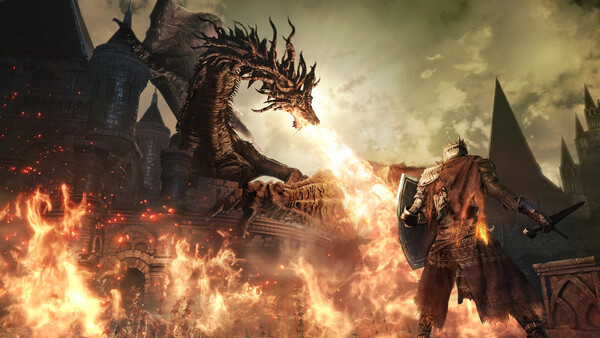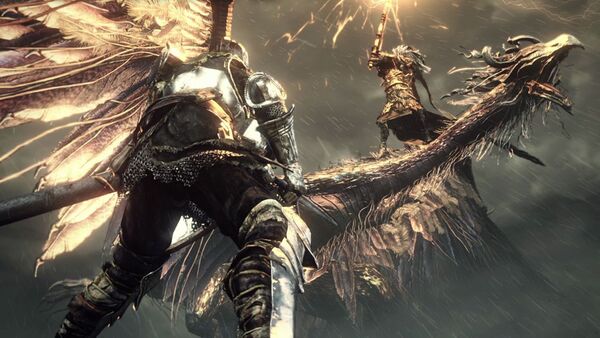**Introduction**
Dark Souls III stands as a testament to the challenging nature of modern gaming, captivating players with its unforgiving mechanics and intricate world design. Unlike many contemporary titles that prioritize accessibility, Dark Souls III demands skill, patience, and perseverance. This article explores the impact of difficulty on player experience, the design philosophies behind the game, and how it fosters a unique sense of achievement.

The Art of Difficulty
Dark Souls III is renowned for its high level of difficulty, a hallmark of the franchise. From the very beginning, players encounter formidable foes and intricate level designs that require precise timing and strategic thinking. The game punishes mistakes, often leading to death—a frequent occurrence that is both frustrating and rewarding.
This brutal difficulty is not arbitrary; it is meticulously crafted to teach players through trial and error. Each death serves as a lesson, encouraging players to learn enemy patterns and adapt their strategies. This iterative process transforms frustration into a sense of progression, where every small victory feels hard-earned.
Level Design and Player Learning
One of the standout features of Dark Souls III is its level design, which intricately intertwines environments and encourages exploration. The interconnected world rewards players for their curiosity, as shortcuts and hidden paths often lead to powerful items or critical lore. This design philosophy promotes learning, as players must navigate complex areas filled with traps and enemies.
For example, the infamous Anor Londo is a masterclass in level design, offering both beauty and peril. Players must carefully traverse this daunting area, using their knowledge from previous encounters to survive. Each new area introduces fresh challenges, requiring players to apply their learned skills effectively.
Combat: A Dance of Precision
Combat in Dark Souls III is a meticulous dance, where timing and precision are paramount. Each weapon type has its own feel, and players must master the intricacies of their chosen arsenal. The stamina management system adds another layer of strategy, as players must balance aggression with defense.
Moreover, the game’s unique online features—such as summonings and invasions—add unpredictability to encounters. Players can choose to summon allies for tough boss battles or face invaders seeking to test their skills. This dynamic creates a rich tapestry of interactions, further enhancing the game’s complexity.
Community and Shared Experience
The Dark Souls community plays a pivotal role in the game’s experience. Players share tips, strategies, and stories of their struggles, creating a sense of camaraderie among those who dare to enter the world of Lothric. This shared experience is integral to the game’s appeal, as players feel a collective achievement in overcoming challenges.
Forums and social media platforms are filled with guides and anecdotes, allowing new players to glean insights from seasoned veterans. The joy of discovery is amplified by the community’s support, transforming individual journeys into shared narratives of triumph.

Emotional Resonance Through Challenge
The emotional highs and lows of Dark Souls III are deeply tied to its difficulty. Moments of triumph, such as defeating a challenging boss after numerous attempts, evoke feelings of elation and satisfaction. Conversely, setbacks can lead to frustration and disappointment, but these feelings are part of the game’s charm.
This emotional rollercoaster creates a profound connection between players and the game. Each death, each victory, adds to the narrative of personal growth, reflecting the player’s journey through struggle and perseverance.
The Role of Lore in Difficulty
Dark Souls III intertwines its challenging gameplay with rich lore, creating a narrative depth that enhances the experience. The cryptic storytelling encourages players to piece together the fragmented tales of fallen heroes and ancient curses, fostering a sense of discovery that parallels the gameplay.
As players confront formidable bosses, they are not just battling for survival; they are engaging with the lore of the world. Each encounter reveals deeper connections to the game’s history, making victories more meaningful as players uncover the stories behind their adversaries.
Design Philosophy: Crafting a Legacy
The design philosophy behind Dark Souls III is rooted in the belief that difficulty fosters engagement. By challenging players, the game cultivates a sense of accomplishment that is often lacking in more accessible titles. This approach has influenced numerous games in the industry, encouraging a trend toward difficulty that resonates with many players.
Developers from various studios have cited Dark Souls as an inspiration, integrating challenging mechanics into their own titles. This legacy solidifies Dark Souls III’s position as not only a game but a cultural phenomenon that reshapes player expectations.

Conclusion: The Reward of Perseverance
Dark Souls III exemplifies the power of challenge in gaming. Through its demanding gameplay, intricate level design, and rich lore, it creates an experience that resonates deeply with players. The journey through Lothric is not just about overcoming obstacles; it’s about personal growth, community, and the satisfaction that comes from embracing difficulty. As players face their fears and emerge victorious, they discover that the true reward lies not just in victory, but in the journey itself.


